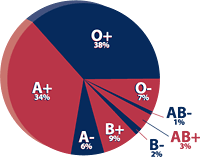 |
 |
 |
 |
 |
|
|
|
The Need For Blood
- More than 4.5 million patients need blood transfusions each year in the US and Canada. would die each year without life saving blood transfusions.
- 43,000 pints of donated blood are used each day in the US and Canada.
- Every three seconds someone needs blood.
On average, one out of every 7 people entering the hospital will need blood.
- Blood banks often run short of type O and B blood.
- The average red-cell transfusion amounts to 2.7 pints.
How Blood Helps
- Each unit of donated blood can be separated into several components (red cells, plasma, platelets, cryoprecipitate).
- As components, just one pint of donated blood can help up to 3 people.
Among 100% of Americans, Blood Types Are Distributed As Follows:

How Blood Works
- Healthy bone marrow makes red cells, plasma, and platelets constantly.
- Blood components fight infection and helps heal wounds.
- Red cells carry oxygen to organs and body tissues.
- Platelets help blood clot and may give people with leukemia and other cancers a chance to live.
Blood Donation
- Must be healthy, 17 or older, and weigh 110 pounds or more.
- Minimum time between donations is 56 days.
- Each donated pint of blood can help up to 3 people.Giving blood takes 45-60 minutes for the entire process (actual donation takes just 7-10 minutes; the rest of the time is for registration, health screening, and rest/snack period).
It’s A Fact...
- Blood makes up about 7% of your body's weight.
A newborn baby has about one cup (8 ounces) of blood in his or her body.
- There are four main blood types: A, B, AB and O. AB is the “universal recipient” and O negative is the “universal donor”.
- Shortages of all types of blood most often occur during summer and winter holidays.
- Giving blood will not decrease your strength.
- You cannot get AIDS or any other infectious disease by donating blood.
Download more fascinating facts about blood and blood donation!


© Michigan Community Blood Centers
|
|
|